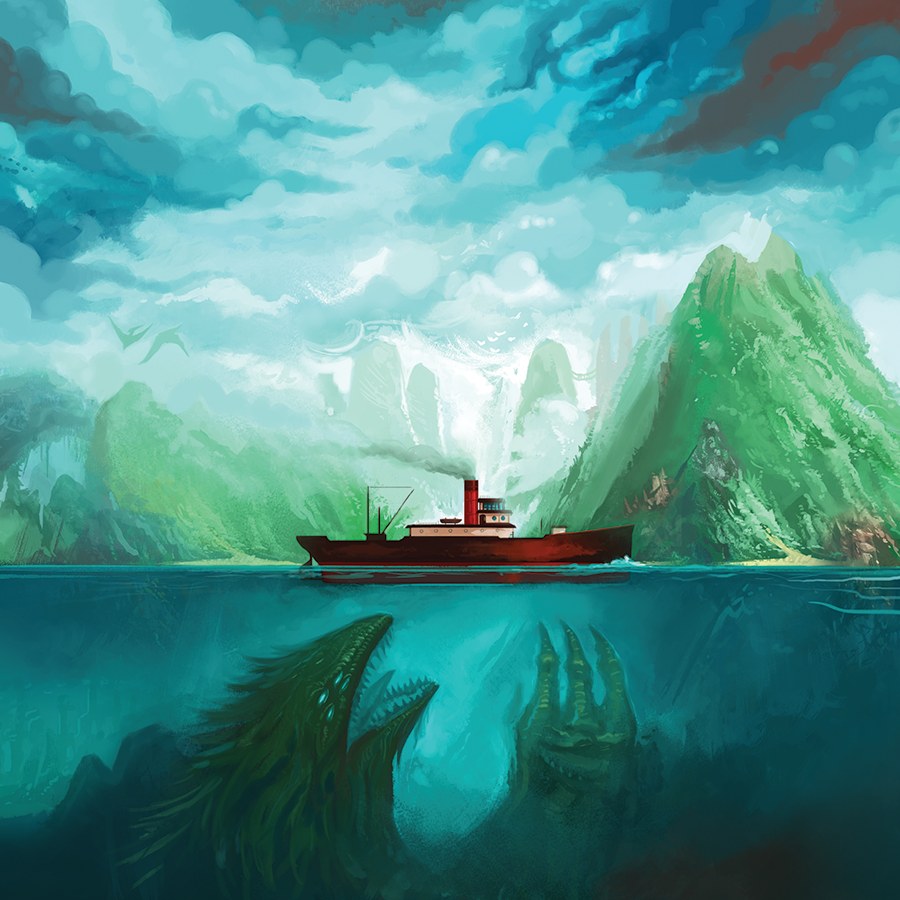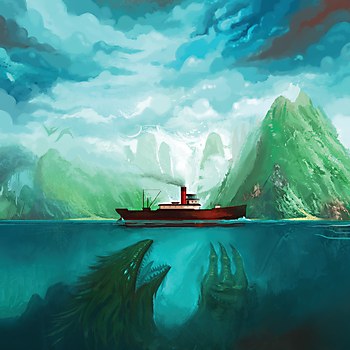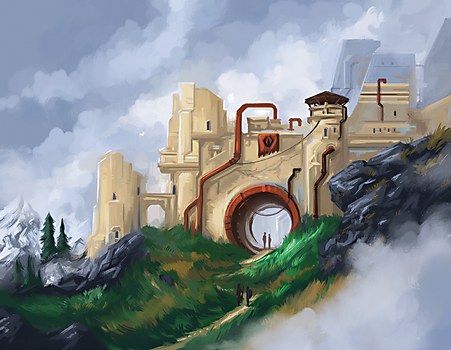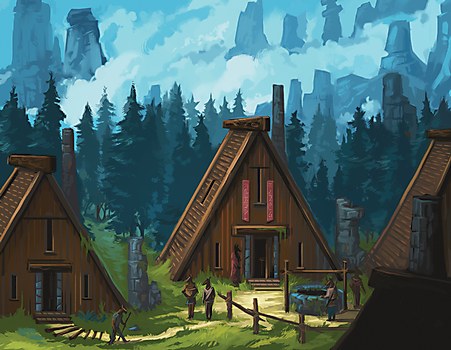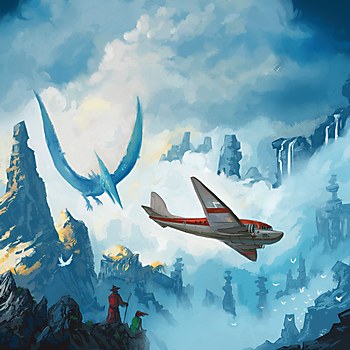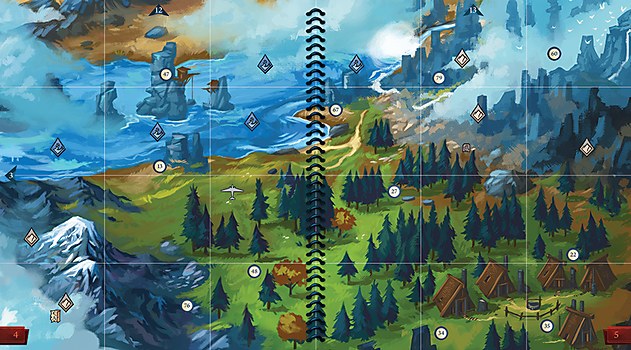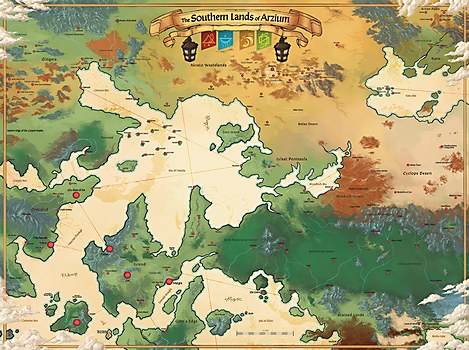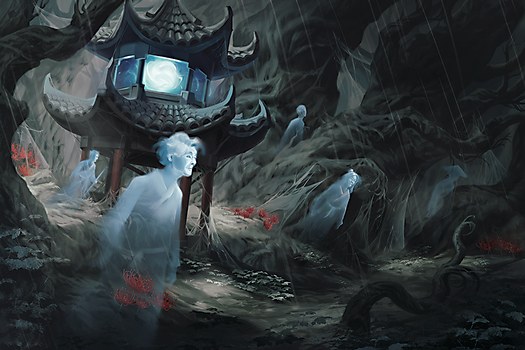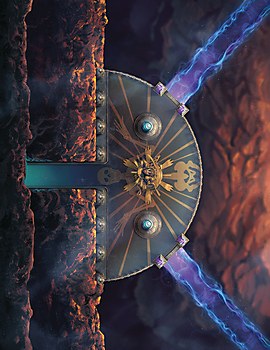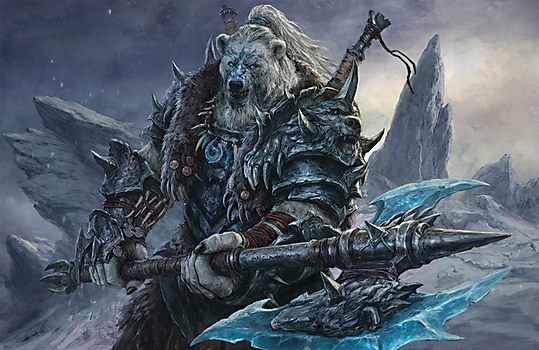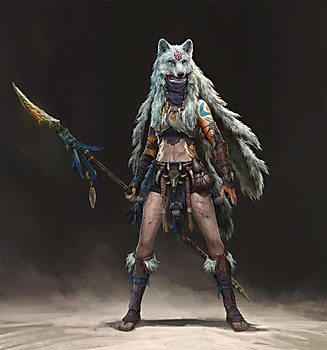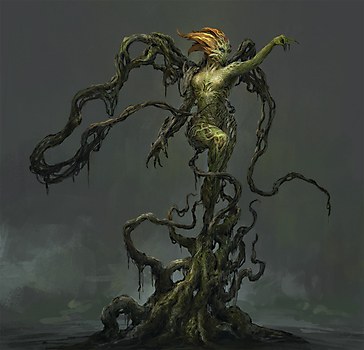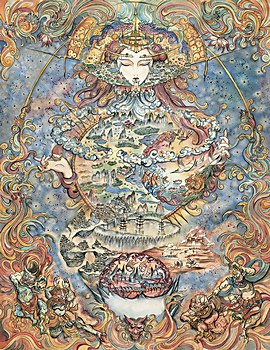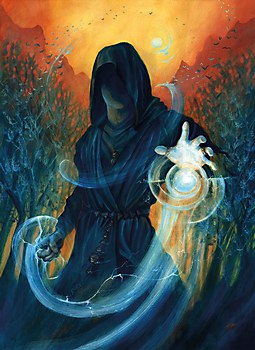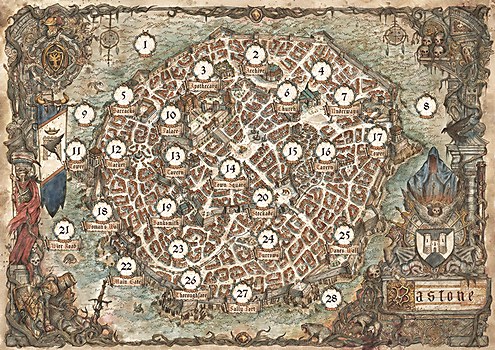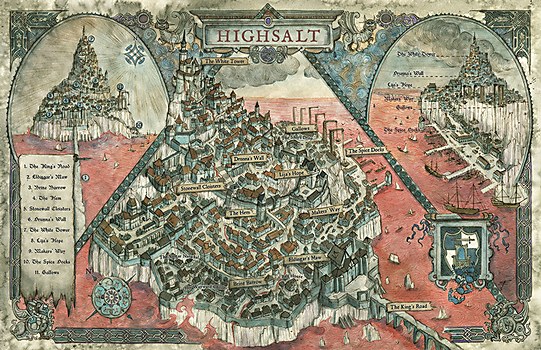For more than a decade now, boardgames have been experiencing a renaissance that has taken the genre to new heights. Think of the tactile pleasures of moving a piece around a board but combined with the imagination of complex tabletop role-playing games (RPGs) like Dungeons & Dragons or the strategies of card games like Magic: The Gathering. And to anchor these games in the minds of their players, illustrators have brought their penchants for worldbuilding and character design to create games that often feel like interactive works of art. I spoke to four illustrators—some who create specialized assets and some who design whole games on their own—about what attracts them to boardgames and about the community that has emerged from the industry.
Browse Projects
Francesca Baerald
 On her website, Reggio nell’Emilia, Italy–based illustrator Francesca Baerald describes herself as a “freelance artist and cartographer,” which makes sense given the numerous maps she’s designed and painted for tabletop games. Replete with details, her work transforms and distills the worlds players imagine into physical artifacts. “Behind each game, there’s an extraordinary amount of lore and game rules to consider,” she explains. “I’d like for players to be 100 percent involved in the setting, and to do so, I must know the game as best as I can. I always strive to give my work authenticity through detail and refinement that can come only from a deep knowledge of the project.”
On her website, Reggio nell’Emilia, Italy–based illustrator Francesca Baerald describes herself as a “freelance artist and cartographer,” which makes sense given the numerous maps she’s designed and painted for tabletop games. Replete with details, her work transforms and distills the worlds players imagine into physical artifacts. “Behind each game, there’s an extraordinary amount of lore and game rules to consider,” she explains. “I’d like for players to be 100 percent involved in the setting, and to do so, I must know the game as best as I can. I always strive to give my work authenticity through detail and refinement that can come only from a deep knowledge of the project.”
Growing up, Baerald always knew she wanted to be involved in a creative career, and right out of a three-year program at the Scuola Internazionale di Comics (“International School of Comics”) in Rome, she took a position as a freelance artist at an Italian gaming company. A decade has passed since then, and Baerald has never looked back. “I can say that giving my passion for drawing a shot was the best choice of my life,” she notes.
Primarily working in ink, acrylic, oil and watercolor on stretched cotton paper, Baerald loves using physical media for its tactile feedback and fleeting materiality, which helps her connect the importance of creating her work. But above all, her inquisitive research processes and attention
to detail contribute most to her success. Take, for example, her work for the card-based RPG Legend of the Five Rings, one that she lists as a favorite project. “I created a great amount of maps and illustrations for it using a style inspired by sumi-e,” she says, referring to the Japanese ink painting technique. “I deeply enjoyed studying that art technique, and even today it is one of the styles I find most pleasant to use in my works.”
Damien Mammoliti
 For Vancouver Island–based illustrator Damien Mammoliti, his entrance into boardgames began with a commission from Polish game developer CD Projekt Red for The Witcher Adventure Game, a tabletop game set in the world of fantasy franchise The Witcher and released in 2014. After completing that, he was contacted by Calgary-based company Roxley Games for Brass: Lancashire, a reboot of the 2007 simulator tabletop game of an Industrial Revolution–era economy. The rest just fell into place.
For Vancouver Island–based illustrator Damien Mammoliti, his entrance into boardgames began with a commission from Polish game developer CD Projekt Red for The Witcher Adventure Game, a tabletop game set in the world of fantasy franchise The Witcher and released in 2014. After completing that, he was contacted by Calgary-based company Roxley Games for Brass: Lancashire, a reboot of the 2007 simulator tabletop game of an Industrial Revolution–era economy. The rest just fell into place.
Mammoliti, who works completely digitally, says that the main consideration illustrators must take when creating work for boardgames is how the art will function. “Boardgames [are art that’s] meant to be interacted with in a tangible way on your table,” he says, “so when considering art [for them], you must consider bleed cuts and user interface. In the case of cards, there will often be a large amount of user interface printed on top of the illustration, so you need to work around that UI to make a decent composition.”
Among his favorite games he’s worked on are Dungeons & Dragons (D&D) and Pathfinder, an RPG based on the rules of D&D’s third edition that was used until 2007. Another he mentions is Radlands, a card-based boardgame where players battle against each other as well as a harsh post-apocalyptic setting. Its vibrant neon palette and cyberpunk inspiration provided a fun departure from Mammoliti’s typical work. “Being able to go wild with the colors and expressive nature of the illustrations was a breath of fresh air,” he says.
Russell Dongjun Lu
 An illustrator based in Wellington, New Zealand, Russell Dongjun Lu initially wanted to draw for comic books, even while pursuing a university degree in engineering. Upon graduation, he found work as a concept artist for video games when Jamie Jolly, a boardgame designer and Lu’s friend, contacted him in 2017 to work as the art director for the game Oathsworn, a boardgame on which Baerald worked as well. Set in a dark medieval fantasy setting with interactive maps and detailed miniatures of player characters and monsters, Oathsworn pits up to four players against a hostile world to fight for humanity’s survival. The concept intrigued Lu—whose work often centers on characters that tell their stories through their appearance—and the project became his entry point into the world of tabletop games. “I’ve found that there isn’t much difference between working as an artist in the video game industry and the boardgame industry,” he observes. “Both have allowed me to use my creative skills and bring imaginative worlds to life, and I’ve purely enjoyed it.”
An illustrator based in Wellington, New Zealand, Russell Dongjun Lu initially wanted to draw for comic books, even while pursuing a university degree in engineering. Upon graduation, he found work as a concept artist for video games when Jamie Jolly, a boardgame designer and Lu’s friend, contacted him in 2017 to work as the art director for the game Oathsworn, a boardgame on which Baerald worked as well. Set in a dark medieval fantasy setting with interactive maps and detailed miniatures of player characters and monsters, Oathsworn pits up to four players against a hostile world to fight for humanity’s survival. The concept intrigued Lu—whose work often centers on characters that tell their stories through their appearance—and the project became his entry point into the world of tabletop games. “I’ve found that there isn’t much difference between working as an artist in the video game industry and the boardgame industry,” he observes. “Both have allowed me to use my creative skills and bring imaginative worlds to life, and I’ve purely enjoyed it.”
When asked about what design elements illustrators need to consider for boardgames, Lu points to three different facets. First is clarity and readability, as artwork might be printed on small pieces or cards with limited space. “Distinctive silhouettes and well-defined details can make a big difference,” Lu notes. Second is how the game’s interactivity impacts its artwork. “Think about how different components of the game interact visually,” he explains. “For example, characters may need to fit onto specific game cards or standees, so their poses and sizes should be compatible [with these pieces.]” Finally, production constraints dictate the amount of detail that illustrators can imbue in their work, especially regarding 3-D character design or map design. “Designs should account for factors like moldability, assembly and paintability to ensure a smooth production process,” Lu explains.
Ryan Laukat
 Salt Lake City–based illustrator and designer Ryan Laukat began creating tabletop games in his youth, sketching and designing maps and decks of cards for his own creations either digitally or in watercolor. To get into the industry, he attended local events and game design conferences; eventually, he got hired as an illustrator on the boardgame series Bridge Troll by publishing company Z-Man. “I traveled to [the boardgame trade show] SPIEL in Essen, Germany, and just walked the booths giving out cards and showing my art,” he explains. “I got a couple more jobs and started taking any jobs I could find.” But as he finished more games for other companies, he realized he was developing skills to publish his own, and soon he founded publishing company Red Raven Games. “As soon as [my] titles were selling and there was demand for more, I dropped all my freelance work and just illustrated my own boardgame designs,” he says.
Salt Lake City–based illustrator and designer Ryan Laukat began creating tabletop games in his youth, sketching and designing maps and decks of cards for his own creations either digitally or in watercolor. To get into the industry, he attended local events and game design conferences; eventually, he got hired as an illustrator on the boardgame series Bridge Troll by publishing company Z-Man. “I traveled to [the boardgame trade show] SPIEL in Essen, Germany, and just walked the booths giving out cards and showing my art,” he explains. “I got a couple more jobs and started taking any jobs I could find.” But as he finished more games for other companies, he realized he was developing skills to publish his own, and soon he founded publishing company Red Raven Games. “As soon as [my] titles were selling and there was demand for more, I dropped all my freelance work and just illustrated my own boardgame designs,” he says.
Laukat chooses to work completely digitally as that helps him keep track of all the game components and how they interact with each other. He notes that illustrating for boardgames requires some design knowledge. “Especially in smaller projects, you’re not just illustrating; you’re doing graphic design and preparing print files with cut lines and bleeds and using programs you may not have needed if you were just illustrating,” he explains. “And, in this industry, you’re always thinking about table presence. When you set a game up on the table, you want its components to draw your players in. It’s like an advertisement to sit down and play when you [see the game] already looks fun.”
His favorite games tend to take place at sea, as Laukat has an affinity for the ocean and the drama of sailing. “Islebound was the first game I published with a seafaring theme, and I still love the deep blue-greens on the cover and the quirky details and vivid colors of the port towns,” he recalls. “Sleeping Gods also captured my love of the sea, maps and sweeping landscapes. I was able to paint an atlas full of maps across all different types of terrain and climates because it was basically an entire world in full-color illustration.”
A booming market for illustrators
While it may seem daunting, there are less barriers to entry in the world of boardgames than might first appear, with the relative size of the industry, the number of independent publishers and the diversity of art styles in games. Mammoliti advises to create a portfolio that will grab the attention of art directors: “It’s not [always] who you know in this sort of industry—though it can be at times, since it’s small,” he says. “If you maintain a great and cohesive portfolio, inquiries will likely come your way!”
Laukat notes that now, when he attends tabletop gaming conventions and trade shows, the explosion of varied games has taken him by surprise. “You walk through a convention and see classic fantasy games; party games; sleek, modern graphic design; and lush, fantastical work,” he says. “You see horror and humor and romance and history. It’s all there, and it’s getting more imaginative.”
For Lu, the future of tabletop gaming looks exciting with new releases becoming increasingly innovative and diverse. “New games with unique styles, mechanics and captivating narratives are being released every month,” he notes. “This also opens opportunities for artists and creators to explore different themes and artistic directions.”
Baerald, however, suspects the market has become saturated with too many games and may start to change course, creating both broadly appealing titles for beginners and more complicated ones for veteran players. “I believe there will be more curated and special edition games that will attract appreciators, so there will probably be an increasing gap between easy-to-grab games and high-quality productions,” she says.
While many players enjoy boardgames because they require friends to be in the same room together, the increasing access to XR technology has also impacted the industry’s landscape.
“In past years, digital [technologies] have been creating a whole new way of playing tabletop games,” Baerald explains, and notably, game designers have increasingly turned to phone apps and AR to enhance gameplay. “When smart glasses become a real thing, the boundaries between tabletop games and videogames will blur very quickly,” she continues, “[but] many players appreciate tabletop games because they want to disconnect from the digital world. Some of us will always love to throw dice, feel a worn playing card in our hands or fiddle with a game piece while choosing our next action.”
And, as AI existentially threatens the work of creatives everywhere, Lu believes that illustrators who develop the skills to create consistent worldbuilding have nothing to fear. “AI can streamline processes and offer new creative possibilities, but the artistic vision and storytelling skills of humans are things you can’t replace,” he notes. “Artists play an important role in creating game worlds, captivating illustrations and unique characters that are essential to the success of tabletop games.”
Most importantly, the tabletop gaming industry fosters an irreplaceable community among its artists and designers. “This is a community where people stay involved and invested,” Laukat says. “I think the boardgame industry is a place where people not only find entertainment but opportunities to pursue their creative passions. And that makes me proud to be a part of it.” ca









